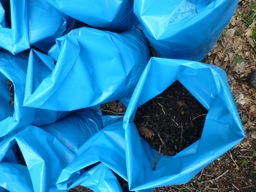Last Updated on December 20, 2024 by Thompson & Morgan Horticultural Team
Leafmould is the black gold of gardening. Ten or more years back, I worked in nursery on a rare hill on the Suffolk Essex border. We are talking small scale, husband and wife team, working all hours of day and days of year. The only time off was to load a large blue van with unusual and mouthwatering plants – arisaemas, trilliums and the like and drive to London to set up a mini fairy garden for the Chelsea Flower Show or exhibitions in the RHS’s Floral Halls. Bulbs and other woodland plants were their speciality. Anyway, I digress: their potting medium was leafmould.

New tree mulched with leafmould
So what exactly is this stuff? Simply leaves that are well rotted, nothing else added. The final product has no nutrients but crumbles down like rich dry chocolate cake – Sachertorte – to be precise. In this form it acts as a soil conditioner. Those with an open sandy soil will know how fast minerals get leached out and moisture too. The leafmould will bind the structure of the soil to help improve water retention.
Clay is more of a problem to work with than sand. Clay soils are intrinsically fertile but the individual particles grab each other so tightly that hallmarks are swamped out wet in winter and cracked dry in summer. Leafmould, by a weird process known as deflocculation, persuades the soil to open up, drainage improves and digging and otherwise working the soil become a good deal easier.

A cage for storing leaves – yours can be much more simple though
Leaves do not rot down in the same way as other garden waste. For this reason store them separately in a cage made of chicken wire. If you can soak them thoroughly now and again in the hot long summer days and turn them once or twice, decomposition will be accelerated.

Leafmould for sale at Fairhaven Trust, Norfolk
The best way to use the leafmould is to put it on as a thick layer over your beds in the very late autumn. It will help conserve soil warmth and act as a mulch. It is almost impossible to buy this fabulous product – I have only seen it for sale at the Fairhaven Trust in Norfolk. But get ahead and make your own. All you need are some stout stakes and chicken wire. And as mentioned above, it is a great medium to use for potting up plants.
Catharine Howard is a designer, garden coach, the gardening editor of Essential Suffolk Magazine, and garden writer. Topics are anything to do with horticulture and the inspiration behind design. She lives and gardens in Suffolk. Catharine also contributes to ThinkinGardens, Guardian garden blog and IntoGardens.

@Emma Williams,
You can make leave mould in black plastic bags. However you need to make a number of holes in the bag(s) to allow air flow and excess water to run out. Give the bags a good shake every few weeks to add air into the mix. “A horrible sticky mess” sounds like you’re either adding too much water, or havent added any, or enough holes. You’re probably going to have to wait 1-2 years for the leaf mould to develop.
Ahh….I put my leaves into black bags and they turned into a horrible sticky mess. Now I n
Know how to make leaf mould properly. Many thanks